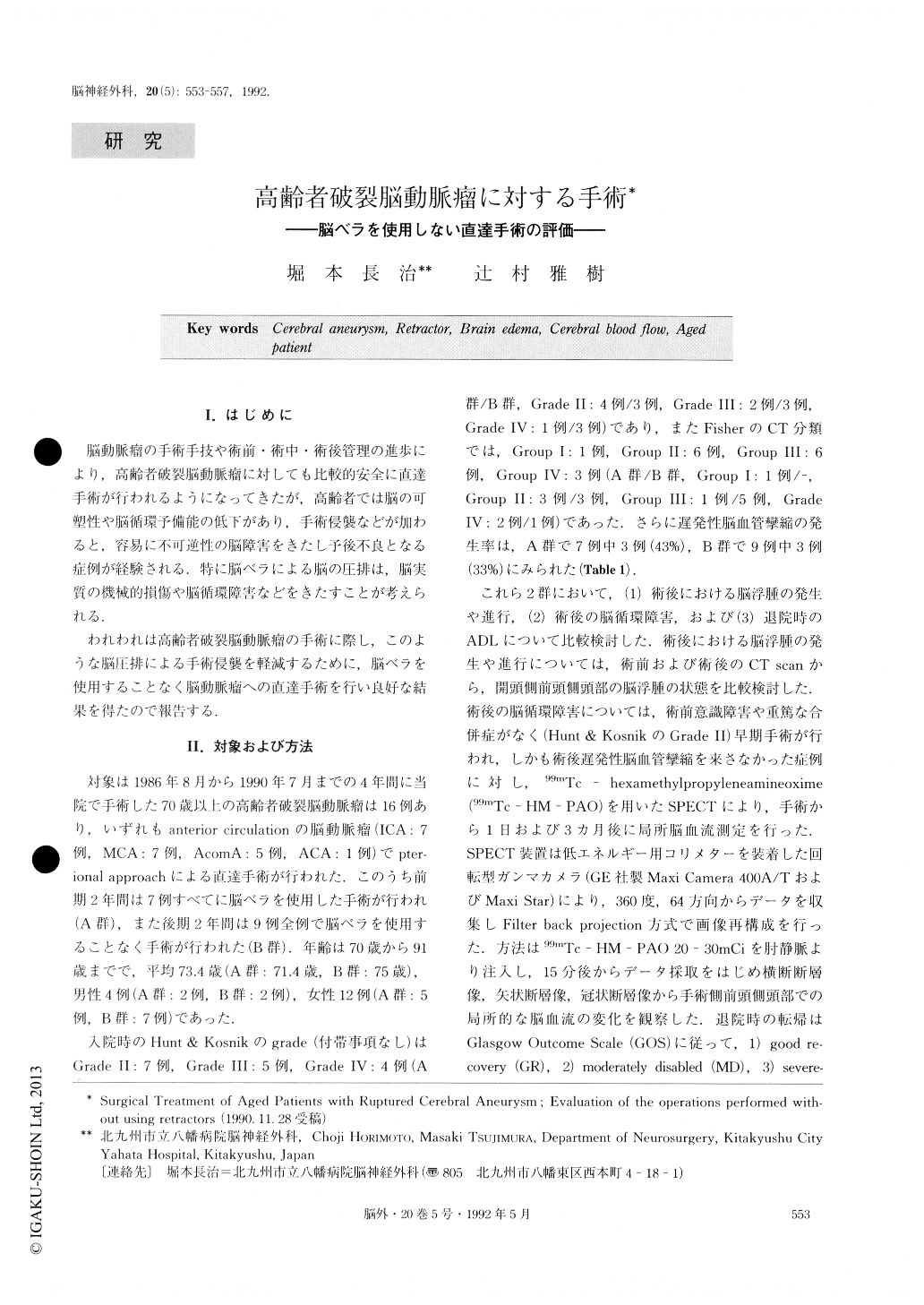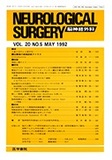Japanese
English
- 有料閲覧
- Abstract 文献概要
- 1ページ目 Look Inside
I.はじめに
脳動脈瘤の手術手技や術前・術中・術後管理の進歩により,高齢者破裂脳動脈瘤に対しても比較的安全に直達手術が行われるようになってきたが,高齢者では脳の可塑性や脳循環予備能の低下があり,手術侵襲などが加わると,容易に不可逆性の脳障害をきたし予後不良となる症例が経験される.特に脳ベラによる脳の圧排は,脳実質の機械的損傷や脳循環障害などをきたすことが考えられる.
われわれは高齢者破裂脳動脈瘤の手術に際し,このような脳圧排による手術侵襲を軽減するために,脳ベラを使用することなく脳動脈瘤への直達手術を行い良好な結果を得たので報告する.例えばLAK細胞のキラー活性のトリガー分子であるCD3およびCD16に対する単クローン抗体(mAb)と抗腫瘍細胞mAbとを化学的に架橋したキメラ抗体を併用する方法,また種々のサイトカイン(IL-4,IL-6, γ-IFN)を用いたBRM(Biological ResponseModifier)療法等である6,19,20).一方,悪性腫瘍の病理学的特徴として認められる腫瘍浸潤リンパ球の治療応用が挙げられる.TILは,腫瘍内及び周囲で,持続的抗原感作をうけMHC拘束性で自己腫瘍細胞に対し高い殺細胞性を有するとともに,in vivoでLAK細胞と比較して著明な腫瘍集積性を示すからである13,14,23).TILの生物活性,特異性,作用機構を分析することは細胞,分子レベルブのリンパ球-腫瘍細胞相互作用を知り,抗腫瘍活性の解明,さらに効率のよい養子免疫療法の開発に役立つものである.特に血液-脳関門の存在よりT細胞の分布,抗原提示細胞,抗体産生機序を異にする脳内に於ては,更に重要と考えられる.現在までに,このTILの表面形質(CI)3+,8+,TCR α β+),キラー活性の機能解析は主に抗原性の強いメラノーマで行われてきた3,13,14).しかし,悪性グリオーマTILに於ては,機能解析,特にMHC,抗原特異性に関する研究は十分でなく,表而形質の分析が若干進んでいるのみにすぎない4,9,11).また,TILの腫瘍抗原認識に於けるT糸田胞レセプター(TCR)α,β鎖の同定,抗原に対するMHCとの関連にいたっては令く検討されていない.今回,われわれは眼窩メラノーマTILのTCRα鎖V領域(Variable region;Vα)に,restricted,predo-minant usageがあることが明らかとなり,同様の手技を用いて悪性グリオーマTILのTCRαおよびβ鎖レパートリーを検討した21).
Abstract
Sixteen patients over 70 years of age with ruptured cerebral aneurysms in the anterior circulation were sur-gically treated via the pterional approach. Self-retaining brain retractors (SRBRs) were used in seven patients (Group A) , but not in nine other patients (Group B) . On admission there were no significant differences be-tween the groups in terms of the neurological grading of Hunt & Kosnik or the CT grading of Fisher. The timing of the operation was decided on the basis of the neurological grading of Hunt & Kosnik and the syste-mic complications present in each case. Early operation (within 2 days) was performed in 10 cases (5 cases in each group), whereas delayed operation (after 15 days) was carried out in 6 cases (Group A : 2 cases ; Group B: 4 cases) . Symptomatic vasospasm occurred in 43% of Group A and in 33% of Group B Postoperative CT scans showed new or aggravated brain edema in the fronto-temporal region (the site of craniotomy) in 3 Group A cases, but not in any Group B cases.
By means of technetium-99m-labeled hexamethyl-propyleneamine oxime single photon emission com-puted tomography (SPECT) the regional cerebral blood flow (CBF) in the fronto-temporal region of the operated side was studied in 6 patients (3 cases in each group) one day after and three months after the opera-tion. One day after the operation, the regional CBF in the fronto-temporal region had decreased in the three Group A cases, but no changes were observed in the three Group B cases. Three months after the operation the regional CBF impairment had improved in 2 of the Group A cases.
Based on the Glasgow outcome scale, at the time of discharge, the overall outcome in Group A and Group B were about the same with regard to moderate disabil-ity, severe disability, vegetative state and death. However good recovery was observed only in Group B, in which there had been no impairment of the regional CBF on SPECT, and no increase in brain edema on the post operative CT scan.
It is surmised that the operation without using retrac-tors provides good results in aged patients with rup-tured cerebral aneurysms.

Copyright © 1992, Igaku-Shoin Ltd. All rights reserved.


